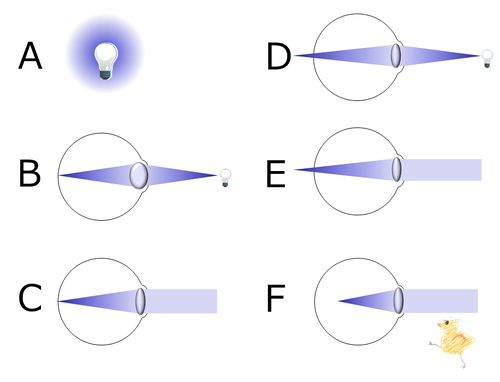「Nerve06/eyes and ears/focus adjustment」の版間の差分
Soichi.Nakatake (トーク | 投稿記録) 編集の要約なし |
Soichi.Nakatake (トーク | 投稿記録) 編集の要約なし |
||
| 6行目: | 6行目: | ||
{{QuizTitle}} | {{QuizTitle}} | ||
<GIFT> | |||
//LEVEL:2 | //LEVEL:2 | ||
//RAND | //RAND | ||
2012年9月23日 (日) 14:42時点における版
From a certain point, light spreads to all directions (A). This light reaching the eye, from some distance away, will have a certain spreading angle at the lens (B). Since the lens can refract (bend) the path of the light, it can converge this spreading angle. When the paths converge to one point at the retina, the point A will not be blurred, but rather clearly seen. This is called 'in focus'. Secondly, if point A is at a far distance, then the path of the light reaching the lens would be parallel (C). In a normal eye, when the lens is thinnest (with least refractive bending power), the light path from a far distance converges to one point. However, if the lens remains thin and the light originates closer to the eye, the light path will converge to one point behind the retina (D). Thus, in this circumstance, the refractive power (thickness) of the lens needs to be increased for focusing.
The ciliary body surrounds the lens (like the rings of saturn) and pulls the lens outwards, making the lens thin. When the circular muscles in the ciliary body contract, the diameter of the ciliary body decreases, and the lens becomes thicker. So, when the ciliary muscles are dilated, the diameter is increased, pulling the lens outwards, thereby decreasing the thickness and the refractive (bending) power of the lens. When the point is near, the ciliary muscle contracts, the diameter is decreased, increasing the thickness and the refractive (bending) power of the lens. This is done by the parasympathetic nerve activity of the oculomotor (III cranial) nerve.
Challenge Quiz
When focusing on a near point, the ciliary muscle contracts. dilates , and the lens becomes thick. thin .
